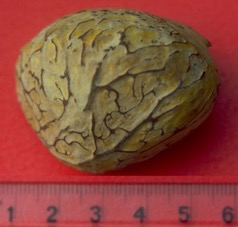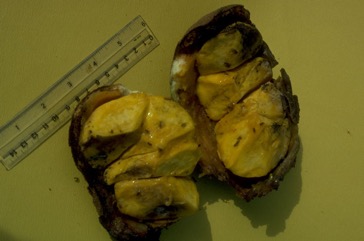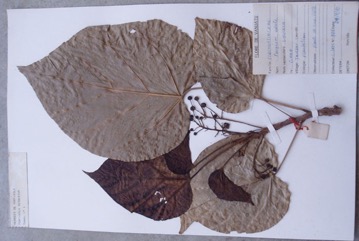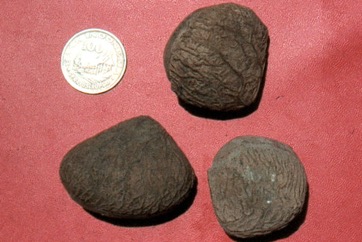Sis, Pangi, Kluwak tree

A tropical plant. It is native to SE Asia. It is a plant of the hot humid tropics. They are widely distributed in primary forests and clearings at low and medium altitudes from southern Luzon to Palawan and southern Mindanao in the Philippines. It mostly grows below 300 m altitude but can be up to 1000 m. It is in the lowland and mid altitude rainforests often near creeks. It prefers slightly acidic soils. It can be in mangrove swamps.
Also known as:
Ariammel, Bauh keluak, Black nut, Bua keluak, Dahdah, Duhrien, Funge, Hapesong, Kapayang, Kayu tuba buwah, Kepayang, Kluwek, Pachung, Pakem, Payang, Pohon kluwak Puchong, Puchung, Raun vange, Riamel Simaung, Ru dohdoh, Siburu, Siwamang, Suwung, Tuhriaen, Vange, Wak
Synonyms
- Pangium rumphii Voigt.
- Hydnocarpus polyandra Blanco
- Pangium ceramense Teysm. & Binn. ex Boerl.
- Pangium naumannii Warb.
Edible Portion
- Seeds, Nut, Leaves (old), Spice, Fruit
Where does Sis grow?
Found in: Andamans, Asia, Bougainville, East Timor, FSM, Guam, Indochina, Indonesia, Kosrae, Malaysia, Micronesia, Pacific, Palau, Papua New Guinea, PNG, Philippines, Pohnpei, SE Asia, Singapore, Solomon Islands, Thailand, Timor-Leste, Vanuatu, Yap
Notes: There is only one Pangium species. Also put in the Flacourtiaceae and Salicaceae family.
Status: Seeds are sold in markets. The tree is moderately common in coastal areas of Papua New Guinea, but the nut is not always eaten. It is popular near Madang.
Growing Sis, Pangi, Kluwak tree
Cultivation: Plants grow wild and are also cultivated from seeds. Seeds can float for a long time in water.
Edible Uses: The old leaves are eaten after shredding and being cooked. The fleshy portion around the seeds is eaten raw or cooked. The seeds are eaten after steeping and roasting in an extensive process to remove poison. Sometimes seeds are buried and fermented for about 40 days. The seeds yield a cooking oil. CAUTION All parts of the plant can contain large amounts of poison (Prussic acid). This must be thoroughly removed by processing. Mature fruit are less poisonous than young fruit.
Production: Trees start to fruit when about 10-15 years old. Trees live for a long time. Fruiting is seasonal and the fruit season tends to be May to August.
Nutrition Info
per 100g edible portion| Edible Part | Energy (kcal) | Protein (g) | Iron (mg) | Vitamin A (ug) | Vitamin c (mg) | Zinc (mg) | % Water |
|---|---|---|---|---|---|---|---|
| Leaves | 106 | 6.2 | 7.3 | - | - | 25 | 71.2 |
| Fruit | 227 | 7.3 | 21 | - | - | 14 | 57.7 |
Sis, Pangi, Kluwak tree Photos




References
Awasthi, A.K., 1991, Ethnobotanical studies of the Negrito Islanders of Andaman Islands, India - The Great Andamanese. Economic Botany 45(2) pp274-280
Barwick, M., 2004, Tropical and Subtropical Trees. A Worldwide Encyclopedic Guide. Thames and Hudson p 308
Batet, K., Koil, U., and Hertel, H., 1998, Traditional Plant Use by the Didipa Clan, Baitabag, Papua New Guinea. GDS. p 41
Borrell, O.W., 1989, An Annotated Checklist of the Flora of Kairiru Island, New Guinea. Marcellin College, Victoria Australia. p 80, 100+10, 190
Bourke, M., 1995, Edible Indigenous Nuts in Papua New Guinea. In South Pacific Indigenous Nuts. ACIAR Proceedings No 69, Canberra. p 46
Bremness, L., 1994, Herbs. Collins Eyewitness Handbooks. Harper Collins. p 71
Brown, W.H., 1920, Wild Food Plants of the Philippines. Bureau of Forestry Bulletin No. 21 Manila. p 122
Burkill, I.H., 1966, A Dictionary of the Economic Products of the Malay Peninsula. Ministry of Agriculture and Cooperatives, Kuala Lumpur, Malaysia. Vol 2 (I-Z) p 1680
Cabalion, P. and Morat, P., 1983, Introduction le vegetation, la flore et aux noms vernaculaires de l'ile de Pentcoste (Vanuatu), In: Journal d'agriculture traditionnelle et de botanique appliquee JATBA Vol. 30, 3-4
Chai, P. P. K. (Ed), et al, 2000, A checklist of Flora, Fauna, Food and Medicinal Plants. Lanjak Entimau Wildlife Sanctuary, Sarawak. Forestry Malaysia & ITTO. p 164
Evans, B. R, 1999, Edible nut Trees in Solomon Islands. A variety collection of Canarium, Terminalia and Barringtonia. ACIAR Technical Report No. 44 96pp
Facciola, S., 1998, Cornucopia 2: a Source Book of Edible Plants. Kampong Publications, p 117
Lepofsky, D., 1992, Arboriculture in the Mussau Islands, Bismarck Archipelago. Economic Botany, Vol 46, No. 2, pp. 192-211
French, B.R., 1986, Food Plants of Papua New Guinea, A Compendium. Asia Pacific Science Foundation p 193
French, B.R., 2010, Food Plants of Solomon Islands. A Compendium. Food Plants International Inc. p 181
Havel, J.J., 1975, Forest Botany, Volume 3 Part 2 Botanical taxonomy. Papua New Guinea Department of Forests, p 211
Hedrick, U.P., 1919, (Ed.), Sturtevant's edible plants of the world. p 461
Henning, B. M., 2014, The Diversity of Conservation: Exploring Narratives, Relationships and Ecosystem Services in Melanesian Market-based Biodiversity Conservation. Ph D dissertation, Uni of Minnesota. p 209
Henty, E.E., 1980, Harmful Plants in Papua New Guinea. Botany Bulletin No 12. Division Botany, Lae, Papua New Guinea. p 64, 65
Hide, R. L., (Ed.) 1984, Research Report of the Simbu Land Use Project. Vol.V1 South Simbu: Studies in Demography, Nutrition, and Subsistence. p 434
Hoe, V. B. & Siong, K. H., 1999, The nutritional value of indigenous fruit and vegetables in Sarawak. Asia Pacific J. Clin. Nutr. 8(1):24-31
http://palaeoworks.anu.edu.au/Nuno_PhD/04.pdf re Timor
Lebot, V. & Sam, C., Green desert or ‘all you can eat’? How diverse and edible was the flora of Vanuatu before human introductions?. Terra australis 52 p 410
Menninger, E.A., 1977, Edible Nuts of the World. Horticultural Books. Florida p 120
Monsalud, M.R., Tongacan, A.L., Lopez, F.R., & Lagrimas, M.Q., 1966, Edible Wild Plants in Philippine Forests. Philippine Journal of Science. p 471
Morley, B. & Everard, B., 1970, Wild Flowers of the World. Ebury press. Plate 118
Nombo, P. & Leach, J. 2010, Reite Plants: An Ethnobotanical Study in Tok Pisin and English. ANU press. p 104
Ochse, J.J. et al, 1931, Vegetables of the Dutch East Indies. Asher reprint. p 293
Owen, S., 1993, Indonesian Food and Cookery, INDIRA reprints. p 69
Pawera, L., et al, 2020, Wild Food Plants and Trends in Their Use: From Knowledge and Perceptions to Drivers of Change in West Sumatra, Indonesia, Foods. 2020, 9, 1240
Peekel, P.G., 1984, (Translation E. E. Henty), Flora of the Bismarck Archipelago for Naturalists, Division of Botany, Lae, PNG. p 385, 382
PROSEA No. 2
Siong, K. H., 2003, Indigenous Fruits of Sarawak. ITTO & Sarawak Forest Department. p 72
Sleumer, H., 1954, Flacourtiaceae in Flora Malesiana, Ser 1 Vol 5(1) p 36
Solomon, C., 2001, Encyclopedia of Asian Food. New Holland. p 44
Sukarya, D. G., (Ed.) 2013, 3,500 Plant Species of the Botanic Gardens of Indonesia. LIPI p 430
Sukenti, K., et al, 2016, Ethnobotanical study on local cuisine of the Sasak tribe in Lombok Island, Indonesia. Journal of Ethnic Foods. 3 (2016) 189-200 p 198
Sunanto H., 1993, Budidaya Pucung. Usaha Produksi Kluwak Dan Minyak Kepayang, Penerbit Kanisius.
Syll. Pl. Nov. 2:13. 1826 (ex Blume, Catalogus 112. 1823, nom. nudum)
Terra, G.J.A., 1973, Tropical Vegetables. Communication 54e Royal Tropical Institute, Amsterdam, p 64
USDA, ARS, National Genetic Resources Program. Germplasm Resources Information Network - (GRIN). [Online Database] National Germplasm Resources Laboratory, Beltsville, Maryland. Available: www.ars-grin.gov/cgi-bin/npgs/html/econ.pl (10 April 2000)
Walter, A & Sam, C., 1995, Indigenous Nut Trees in Vanuatu: Ethnobotany and Variability. In South Pacific Indigenous Nuts. ACIAR Proceedings No 69. Canberra. p 57
Walter, A. & Sam C., 2002, Fruits of Oceania. ACIAR Monograph No. 85. Canberra. p 219
World Checklist of Useful Plant Species 2020. Royal Botanic Gardens, Kew
www.manoa.hawaii.edu/botany/plants of micronesia